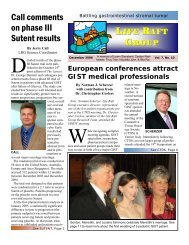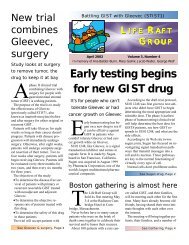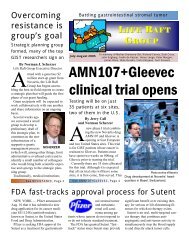GIST Pathology PowerPoint by Dr. Rosenberg - The Life Raft Group
GIST Pathology PowerPoint by Dr. Rosenberg - The Life Raft Group
GIST Pathology PowerPoint by Dr. Rosenberg - The Life Raft Group
Create successful ePaper yourself
Turn your PDF publications into a flip-book with our unique Google optimized e-Paper software.
A 43 year old male presents with abdominal<br />
complaints. An axial CT reveals ….
Diagnosis: Gastrointestinal Stromal Tumor<br />
Location: stomach<br />
Size: 12 cm<br />
Mitotic count: 10 mitoses / 50<br />
high power fields<br />
Risk Assessment: High risk<br />
of aggressive behavior<br />
Mutation status: ?<br />
C-kit
Gastrointestinal Stromal Tumors (<strong>GIST</strong>)<br />
Understanding <strong>Pathology</strong> and the Role of<br />
Mutations in Treatment<br />
What is a <strong>GIST</strong><br />
How is it going to behave<br />
What is the science of <strong>GIST</strong><br />
Why did I get a <strong>GIST</strong><br />
Who gets a <strong>GIST</strong>
Gastrointestinal Stromal Tumors<br />
Definition<br />
Epidemiology<br />
<strong>Pathology</strong><br />
Molecular pathology<br />
oncogenic mutations<br />
Prognostic Features
Cancer<br />
A malignant tumor/neoplasm<br />
- has the biological capacity to metastasize<br />
Classified according to the normal tissues of the<br />
body<br />
Epithelium – carcinoma<br />
Melanocytes - melanoma<br />
Immune cells – lymphoma/leukemia/myeloma<br />
Connective tissue - sarcoma
Gastrointestinal Stromal Tumor<br />
Definition: A mesenchymal neoplasm<br />
whose line of differentiation recapitulates<br />
the cells of Cajal and has a broad<br />
spectrum of biological behavior.<br />
Benign<br />
Malignant
Gastrointestinal Stromal Tumors<br />
Epidemiology<br />
1% GI malignancies<br />
3,300-6,000 new clinically significant<br />
cases/year in U.S.<br />
11-20 per million persons<br />
10-30% behave clinically malignant<br />
Gastrointestinal Stromal Tumors<br />
35<br />
30<br />
%<br />
25<br />
20<br />
15<br />
10<br />
5<br />
0<br />
1 2 3 4 5 6 7 8 9<br />
Age (decades)<br />
Gender: M:F = 1:2
Gastrointestinal Stromal Tumors<br />
Clinical Findings<br />
Depends on size, location and invasion<br />
of other organs<br />
Abdominal mass, GI bleeding, pain, anorexia, perforation,<br />
fever<br />
Site specific<br />
Incidental finding
Gastrointestinal Stromal Tumors<br />
5%<br />
60%<br />
Gastrointestinal Stromal Tumors
Gastrointestinal Stromal Tumors
Gastrointestinal Stromal Tumors
Gastrointestinal Stromal Tumors<br />
Tumor Feature<br />
Risk Stratification<br />
Risk of Progression<br />
Mitoses Size (cm) Stomach Duod Jej/Ileum Rectum<br />
2≤5 very low (1.9%) low (8.3%) low (4.3%) low (8.5%)<br />
>5≤10 low (3.6%) high (34%) mod (24%) high (57%)<br />
>10 mod (12%) high (52%)<br />
≥5/50 hpf ≤2 very low (0%) high (50%) high (54%)<br />
>2≤5 mod (16%) high (50%) high (73%) high (52%)<br />
>5≤10 high (55%) high (86%) high (85%) high (71%)<br />
>10 high (86%) high (90%)<br />
J Surgical Oncology 2011;104:865-873
Gastrointestinal Stromal Tumors<br />
Immunohistochemical profile<br />
C-Kit: 85-100%<br />
DOG-1: 85-100%<br />
CD 34: 30-100%
Gastrointestinal Stromal Tumors<br />
C-kit
Gastrointestinal Stromal Tumors<br />
Terminology<br />
Gastrointestinal stromal tumor;<br />
Mazur 1983<br />
Interstitial Cells of Cajal<br />
Described > 100 yrs ago<br />
Located throughout GI tract<br />
Function as ‘pacemaker’ and<br />
mediator of neuro<br />
transmission<br />
C-Kit vital to development and function
Motor neuron<br />
Interstitial cell of Cajal<br />
Smooth muscle cell<br />
Smooth muscle cell<br />
Smooth muscle cell<br />
Smooth muscle cell<br />
Smooth muscle cell<br />
Smooth muscle cell<br />
Smooth muscle cell
C-KIT<br />
Protein – cell surface receptor - tyrosine kinase<br />
Chromosome 4, Development of heme stem<br />
cells, germ cells, mast cells, melanocytes,<br />
interstitial cells of Cajal<br />
Cell survival<br />
Cell proliferation<br />
Cell adhesion<br />
Cell differentiation and maturation
Gastrointestinal Stromal Tumor<br />
Genetic disease - caused <strong>by</strong> mutations
Molecular Classification of <strong>GIST</strong><br />
5-8%<br />
6% 2%
Gastrointestinal Stromal Tumors<br />
C-Kit Mutations<br />
Described 1998<br />
Located on chromosome 4<br />
Found in 75-80% of <strong>GIST</strong><br />
Mutations activate the tyrosine<br />
kinase receptor<br />
PDGFRa Mutations<br />
Located on chromosome 4<br />
Found in 5-8% of <strong>GIST</strong><br />
Mutations activate tyrosine<br />
kinase receptor<br />
Exon 9<br />
Exon 11<br />
Exon 13<br />
Exon 14
Gastrointestinal Stromal Tumors<br />
Inactive KIT or PDGFRa<br />
Active Kit or PDGFRa<br />
Ligand binding<br />
Oncogenic mutations<br />
Stem<br />
Cell factor<br />
Signalling
Gastrointestinal Stromal Tumors<br />
‣ Kit mutations -worse<br />
prognosis than PDGFRa<br />
mutations<br />
‣ deletions in exon 11<br />
most aggressive<br />
‣ Exon 9 mutations<br />
associated with<br />
intestinal location and<br />
more aggressive course<br />
Arch Pathol 2011;135:1298-1310.<br />
‣ PDGFRa exon 14 and 18<br />
mutations - gastric origin,<br />
epithelioid morphology and<br />
favorable outcome
C-Kit and PDGFRa Negative <strong>GIST</strong><br />
Account for 12% of <strong>GIST</strong><br />
epithelioid/stomach<br />
BRAF<br />
NRAS<br />
HRAS<br />
NF1<br />
loss of function mutation<br />
– succinate dehydrogenase &<br />
IGFR amplification
Progression of Molecular<br />
Aberrations in <strong>GIST</strong><br />
Benign<br />
Malignant<br />
Additional CKIT and PDGFRa mutations<br />
Resistance to <strong>Dr</strong>ugs<br />
CKIT<br />
PDGFRa<br />
BRAF<br />
SDH<br />
Chromosome 14, 14q<br />
Loss or monosomy<br />
Chromosome 8q<br />
17q Gains<br />
Chromosome 1p,9p,11p<br />
10, 13q,15q, 22q Loss
<strong>GIST</strong> – Treatment Effect
Gastrointestinal Stromal Tumors<br />
Outcome<br />
Local recurrence 44-66%<br />
spread along serosal sufaces<br />
deposits in liver<br />
5 yr survival 38-65%<br />
60% develop metastases<br />
(18% have metastases at presentation)
Gastrointestinal Stromal Tumors<br />
Summary<br />
<strong>GIST</strong> is the most common mesenchymal tumor of the<br />
bowel and recapitulates the cells of Cajal<br />
<strong>GIST</strong> have the potential to be biologically aggressive –<br />
risk stratification based on size mitotic rate, and<br />
location<br />
<strong>GIST</strong> is associated with mutations (KIT, PDGFRa,<br />
SDH, BRAF) and there is a relationship between<br />
mutation and biological behavior and response to<br />
therapy. Additional mutations are responsible for<br />
acquired resistance to therapy
Picasso at work
Gastrointestinal Stromal Tumors<br />
Etiology<br />
Unknown – vast majority are sporadic; rarely<br />
a complication of prior radiation<br />
Associated with syndromes: Carney’s triad,<br />
Carney-Stratakis syndrome, von<br />
Recklinghausen’s disease type 1<br />
Familial forms
C-Kit
GI Stromal Tumors<br />
Genotype % cases Imat. Resp<br />
KIT exon 11 70% 85%<br />
KIT exon 9 15% 45%<br />
KIT exon 13
Treatment<br />
GI Stromal Tumors<br />
Complete resection; Conventional chemotherapy fails<br />
Imatinib - inhibitor of c-Kit<br />
most effective<br />
Mechanism of Action of Gleevec<br />
ATP<br />
PO 4<br />
Gleevec<br />
ATP<br />
TK<br />
TK<br />
Substrate<br />
Substrate<br />
p210<br />
Bcr-Abl<br />
p210<br />
Bcr-Abl<br />
Gleevec is not entirely selective for Bcr-Abl; it also inhibits c-Kit and PDGF-R.
GI Stromal Tumors<br />
Differential Diagnosis<br />
Fibromatosis<br />
Leiomyoma, leiomyosarcoma<br />
Schwannoma<br />
Inflammatory fibroid polyp
Interstitial Cells of Cajal
GI Stromal Tumors<br />
<strong>GIST</strong> recapitulates cells of Cajal<br />
Similar ultrastructural features and<br />
immunophenoype as cells of Cajal<br />
Similar distribution as cells of Cajal<br />
Both express c-Kit
GI Stromal Tumors<br />
Other Prognostic Features<br />
Proliferation markers<br />
Ki-67, PCNA<br />
Flow Cytometry<br />
aneuploidy
Stem<br />
Cell<br />
Factor<br />
Stem<br />
Cell<br />
Factor<br />
Kit monomer Activated Kit Mutated Kit
GI Stromal Tumors<br />
Morphologic Prognostic Features<br />
Location, size, mitotic activity and<br />
invasion of other organs<br />
Good features: stomach, 5cm,<br />
1 mitosis/50 hpf, non-invasive
Mechanism of Action of Gleevec<br />
ATP<br />
PO 4<br />
Gleevec<br />
ATP<br />
TK<br />
TK<br />
Substrate<br />
Substrate<br />
p210<br />
Bcr-Abl<br />
p210<br />
Bcr-Abl<br />
Gleevec is not entirely selective for Bcr-Abl; it also inhibits c-Kit and PDGF-R.
<strong>GIST</strong> Treated<br />
with Imatinib<br />
Pre-treatment
Gleevec Trials<br />
• Partial response 59%<br />
• Stabilization 28%<br />
• Progression 13%<br />
• If no ckit mutation, 8x more likely to<br />
have progression (44%) vs Exon 11<br />
mutation (5%)
Special <strong>Group</strong>s of <strong>GIST</strong><br />
Children<br />
usually female, usually have epithelioid morphology<br />
Familial <strong>GIST</strong>- inherited mutation in exon 11 Kit gene<br />
ICC hyperplasia & multiple <strong>GIST</strong>, hyperpigmentation<br />
Type 1 von Recklinghausen’s Disease<br />
arise in background of diffuse hyperplasia of ICC,<br />
multiple, lack mutation in KIT + PDGFA<br />
have inactivating mutation of NF1 gene producing<br />
dysfunctional protein neurofibromin<br />
Carny’s triad – gastric <strong>GIST</strong>, pulmonary chondroma,<br />
paraganglioma, no Kit or PDGF mutations
Etiology<br />
GI Stromal Tumors<br />
– unknown<br />
– rare complication of radiation<br />
– associated with Carney’s triad,<br />
von Reckinghausens disease,<br />
type 1, and intestinal neuronal<br />
dysplasia
C-Kit Negative <strong>GIST</strong><br />
Epithelioid morphology<br />
PDGFR-alpha mutations<br />
Originate in omentum/peritoneum<br />
Many are responsive to Imatinib
Imatinib mesylate (Gleevac)<br />
MECHANISM:<br />
Binds to ATP binding<br />
pocket of C-KIT kinase<br />
domain and inhibits<br />
receptor<br />
phosphorylation<br />
Mechanism of Action of Gleevec<br />
ATP<br />
PO 4<br />
TK<br />
TK<br />
Gleevec<br />
ATP<br />
TOXICITY:<br />
Mild anemia, nausea,<br />
diarrhea, muscle cramps<br />
hepatorenal failure (rare)<br />
p210<br />
Bcr-Abl<br />
Substrate<br />
p210<br />
Bcr-Abl<br />
Substrate<br />
Gleevec is not entirely selective for Bcr-Abl; it also inhibits c-Kit and PDGF-R.













